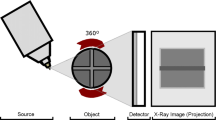Abstract
Objectives
Differentiation of ancient tissues is of key importance in the study of paleopathology and in the evolution of human diseases. Currently, the number of imaging facilities for the non-destructive discrimination of dehydrated tissue is limited, and little is known about the role that emerging imaging technologies may play in this field. Therefore, this study investigated the feasibility and quality of dual-energy computed tomography (DECT) for the discrimination of dry and brittle soft tissue. Moreover, this study explored the relationship between morphological changes and image contrast in ancient tissue by using X-ray micro-tomography (micro-CT).
Materials and Methods
An Egyptian mummy head and neck was scanned with DECT at tube voltage/current of 140 kVp/27 mAs (tube A) and 100 kVp/120 mAs (tube B). The CT attenuation was determined by regions of interest (ROI) measurements of hard and soft tissue of the mummy skull. Finally, two samples from the posterior neck were dissected to acquire micro-CT images of shrunken dehydrated tissue.
Results
Dual-energy CT images demonstrated the high contrast resolution of surface structures from mummy skull. Bone density changes in the posterior skull base as well as soft-tissue alterations of the eyes and tongue were assessed. Micro-CT scans allowed the identification of morphological changes and the discrimination of muscle tissue from inorganic material in samples taken from the neck.
Conclusions
Significant attenuation differences (p < 0.0007) were observed within 12 of the 15 ancient tissue groups and organic materials using DECT. We detected a correlation between X-ray scattering and image contrast reduction in dehydrated tissue with micro-CT imaging.









Similar content being viewed by others
References
Cockburn A, Cockburn E, Reyman TA. Mummies, disease and ancient cultures. Cambridge: Cambridge University Press; 1998.
Hoffman H, Torres WE, Ernst RD. Paleoradiology: advanced CT in the evaluation of nine Egyptian mummies. Radiographics. 2002;22:377–85.
Lewin PK, Harwood-Nash DC. X-ray computed axial tomography of an ancient Egyptian brain. IRCS Med Sci. 1977;5:78.
Aufderheide AC. Progress in soft tissue paleopathology. J Am Med Assoc. 2000;284(20):2571–3.
Stolzmann P. Dual-energy computed tomography for the differentiation of uric acid stones: ex vivo performance evaluation. Urol Res. 2008;36(3–4):133–8.
Graser A, Johnson TRC, Chandarana H, Macari M. Dual energy CT: preliminary observations and potential clinical applications in the abdomen. Eur Radiol. 2009;19:13–23.
Johnson TR, Krauß B, Sedlmair M, Grasruck M, Bruder H, Morhard D. Material differentiation by dual energy CT: initial experience. Eur Radiol. 2007;17(6):1510–7.
Rühli FJ, Kuhn G, Evison R, Müller R, Schultz M. Diagnostic value of micro-CT in comparison with histology in the qualitative assessment of historical human skull bone pathologies. Am J Phys Anthropol. 2007;133(4):1099–1111.
Motley G, Dalrymple N, Keesling C, Fischer J, Harmon W. Hounsfield unit density in the determination of urinary stone composition. Urology. 2001;58:170–3.
Gupta R, Markowitz Y, Berman L, Chapman P. High-resolution imaging of an ancient Egyptian mummified head: new insights into the mummification process. Am J Neuroradiol. 2008;29:705–13.
Persson A, Jakowski C, Engström E, Zachrisson H. Advances of dual source, dual-energy imaging in postmortem CT. Eur J Radiol. 2008;68(3):446–55.
Rylander CG, Stumpp OF, Milner TE, Kemp NJ, Mendenhall JM, Diller KR, et al. Dehydration mechanism of optical clearing in tissue. J Biomed Opt. 2006;11(4):041117.
Donnino R, Jacobs JE, Doshi JV, Hecht EM, Kim DC, Babb JS, et al. Dual-source versus single-source cardiac CT angiography: comparison of diagnostic image quality. Am J Roentgenol. 2009;192:1051–6.
Acknowledgements
We thank Franz Pfeiffer (Paul Scherrer Institute, Villigen, Switzerland) and Paul Stolzmann (Institute of Diagnostic Radiology, University Hospital Zurich, Switzerland) for performing the 3D imaging. The authors thank Jamie Harle (University of Liverpool, UK) for helpful comments on a preliminary draft of the paper.
Author information
Authors and Affiliations
Corresponding author
Rights and permissions
About this article
Cite this article
Wanek, J., Székely, G. & Rühli, F. X-ray absorption-based imaging and its limitations in the differentiation of ancient mummified tissue. Skeletal Radiol 40, 595–601 (2011). https://doi.org/10.1007/s00256-010-1035-9
Received:
Revised:
Accepted:
Published:
Issue Date:
DOI: https://doi.org/10.1007/s00256-010-1035-9




